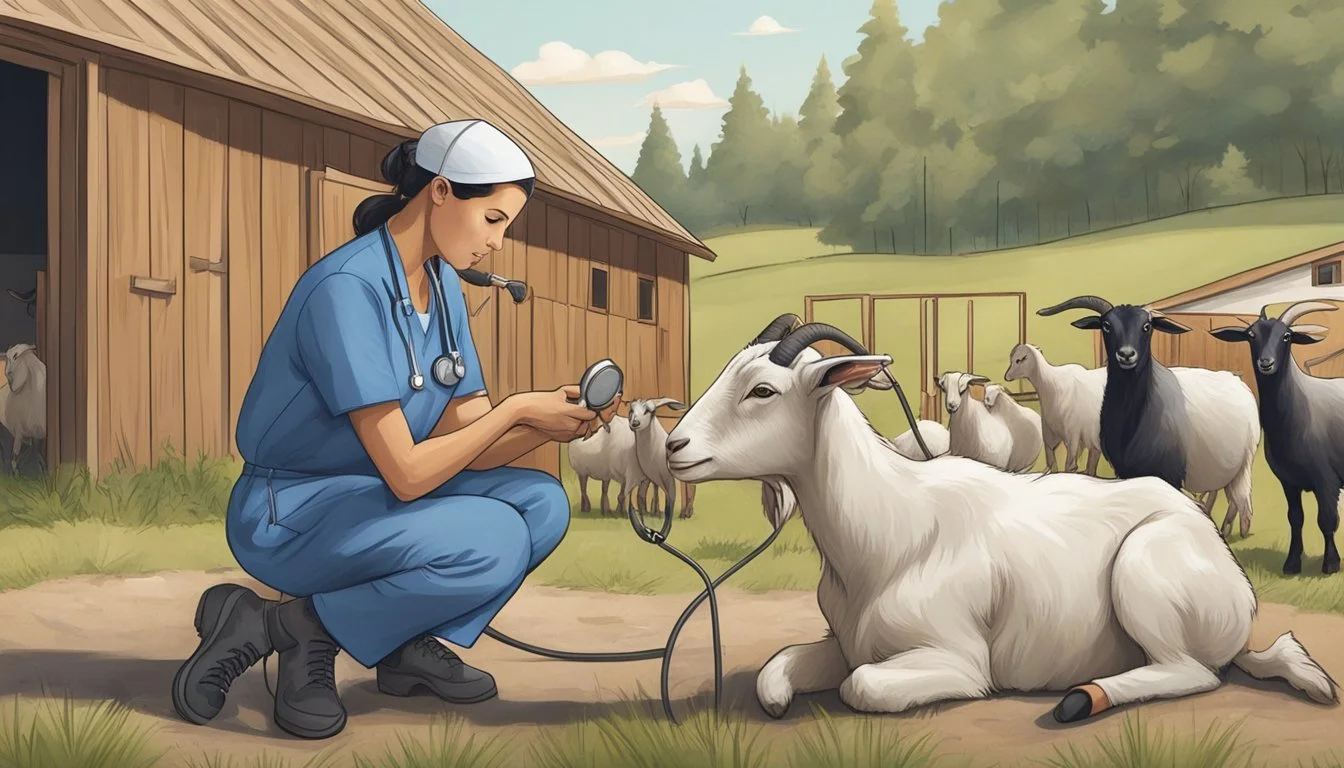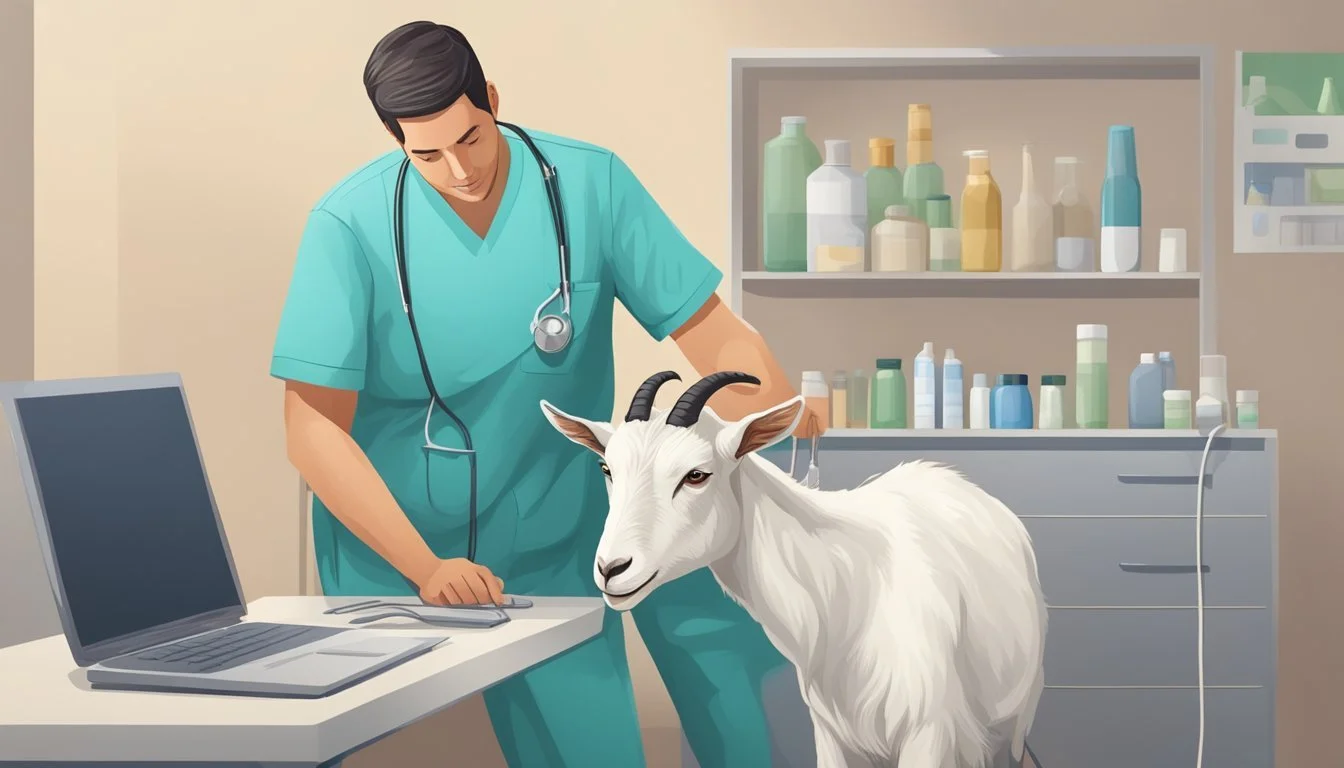What is CAE in Goats
Prevention Strategies and Best Practices
Caprine Arthritis Encephalitis (CAE) is a viral disease that affects goats, having a substantial impact on their health and the productivity of a herd. This disease is part of a group of viruses known as small ruminant lentiviruses, which can cause chronic conditions in various organ systems of affected animals. Manifestations of the disease include arthritis, encephalitis, pneumonia, mastitis, and chronic wasting, each affecting goats in different ways and often resulting in long-term health issues.
Preventing CAE is crucial for maintaining a healthy goat population. The transmission of the disease primarily occurs from mother to offspring through colostrum and milk, making early life the most critical period for controlling the spread of the virus. Effective measures to prevent the spread of CAE include pasteurizing colostrum and milk before feeding it to young goats, implementing rigorous testing protocols, and maintaining a closed herd to minimize the risk of introducing the virus. Regular screening of the herd for CAE, coupled with separating positive animals, significantly reduces the chances of the disease spreading throughout the herd.
Understanding CAE in Goats
Caprine Arthritis Encephalitis (CAE) is a contagious viral disease affecting goats' health and well-being. This disease is caused by a lentivirus, which is part of the same virus family that includes the human immunodeficiency virus (HIV). The Caprine Arthritis Encephalitis Virus (CAE) often results in chronic conditions, most notably arthritis and encephalitis, among others.
Transmission primarily occurs from mother to kid through the ingestion of infected colostrum or milk. Adult goats are also at risk as the virus can spread through body secretions like blood and feces. Due to its viral nature, CAE is deemed incurable, making prevention critical.
Preventive measures include:
Testing: Regular blood screening to detect the virus.
Separation: Isolating infected animals from the rest of the herd.
Hygiene: Ensuring cleanliness to prevent cross-contamination.
Pasturization: Heat-treating colostrum and milk to inactivate the virus.
The virus manifests in multiple forms; however, the lentivirus primarily causes issues in the joints and central nervous system. Clinical signs of CAE can be subtle but may lead to severe and debilitating conditions in the long term.
Understanding and managing CAE in the goat population is essential for herd health. It's recommended that goat owners work closely with a veterinarian to implement effective biosecurity measures to control the spread of the goat disease and maintain a healthy herd. Further insights on managing and preventing CAE can be found through prevention and treatment strategies.
Symptoms of CAE
Caprine Arthritis Encephalitis (CAE), a significant disease affecting goats, can manifest through a distinct set of symptoms, primarily impacting joints, the brain, udder, and respiratory system, and can lead to chronic wasting.
Arthritis and Joint Symptoms
Goats affected by CAE often exhibit swollen joints, which can result in progressive lameness and stiffness. This form of arthritis primarily causes discomfort and may severely restrict movement.
Encephalitis Manifestations
Younger goats may show signs of encephalitis, which affects the brain. Seizures, a head tilt, or even blindness are indications of this condition, indicating serious neurological involvement.
Udder and Mammary Gland Changes
CAE can lead to mastitis, characterized by inflammation and the presence of a hard udder. The mammary glands are typically firm and may be painful, affecting milk production and the goat's overall health.
Respiratory and Pneumonia Issues
Some goats may develop respiratory symptoms leading to pneumonia. Signs include difficulty breathing and an abnormal discharge from the nose, which requires prompt veterinary attention as it could be fatal if left untreated.
Weight Loss and General Symptoms
Finally, chronic wasting in CAE-affected goats is indicated by excessive weight loss and a weak appearance. These general symptoms contribute to an overall deterioration in the animal's health.
Transmission Methods
Caprine Arthritis Encephalitis Virus (CAE) is a serious ailment affecting goats globally. Understanding the transmission methods is crucial to controlling the spread of this contagious disease within herds.
Colostrum and Milk Transmission
Newborn goats often contract CAE through the ingestion of colostrum or milk from an infected doe. This mode of transmission is notably significant as it poses a risk immediately after birth. Dairy goats, which are typically raised for milk production, can inadvertently spread the infection to their offspring during the nursing period.
Vertical Transmission from Doe to Kids
CAE can also spread vertically, where an infected doe transmits the virus to her kids during parturition or birth. While less common, the possibility of in utero transmission should not be neglected. This risk accentuates the need for careful management before and during the birthing process.
Blood and Bodily Fluids
Contaminated blood and other bodily fluids serve as a vehicle for CAE. Exposure can occur through the use of shared needles or equipment during routine herd management procedures. It is imperative to use clean, disinfected tools or single-use items to prevent the disease from being passed among infected goats.
Direct Animal Contact
Lastly, CAE can spread through direct contact between animals. Close physical interactions among goats, such as communal housing or shared feeding spaces, can facilitate the transfer of infected feces and other secretions to susceptible goats. Isolating infected individuals and upholding stringent biosecurity measures are vital steps in thwarting the spread of CAE through direct animal contact.
Diagnosing CAE
Accurate diagnosis of Caprine Arthritis Encephalitis (CAE) in goats is critical to managing the disease and involves a combination of laboratory testing and clinical evaluation by a veterinarian.
Laboratory Testing and ELISA
Laboratory testing for CAE typically involves the Enzyme-Linked Immunosorbent Assay (ELISA), which detects antibodies against the CAE virus in the goat's blood. This ELISA test is a primary tool used to identify CAE-positive animals. It is important to note that goats may test positive for CAE before showing any clinical signs of the disease.
PCR and Advanced Diagnostics
Polymerase Chain Reaction (PCR) testing is another advanced diagnostic approach that can detect the presence of CAE virus's genetic material in blood samples. PCR testing is particularly useful in identifying infection in young goats that have yet to produce a detectable antibody response or in cases where ELISA results are inconclusive.
Clinical Signs and Veterinary Analysis
Veterinarians also diagnose CAE by observing clinical signs. These may include swollen joints, lameness, weight loss, and pneumonia. A veterinarian will perform a thorough clinical examination and may combine this with laboratory results to form a diagnosis. Since some symptoms of CAE can mimic other conditions, it is crucial to rely on professional veterinary analysis to suspect and diagnose CAE.
Treatment and Supportive Care
When addressing Caprine Arthritis Encephalitis (CAE) in goats, treatment focuses on managing symptoms and inflammation, preventing secondary infections with antibiotics, and supporting overall health through proper nutrition and weight management. There is no cure for CAE, but one can take steps to increase a goat's comfort and quality of life.
Managing Symptoms and Inflammation
To effectively manage the symptoms of CAE, which may include arthritis and encephalitis, anti-inflammatory medications and pain relief strategies are commonly employed. It is crucial to:
Administer non-steroidal anti-inflammatory drugs (NSAIDs) to reduce joint pain and swelling.
Monitor and assess the goat's comfort levels regularly.
Antibiotic Usage for Secondary Infections
As CAE can compromise a goat's immune system, secondary bacterial infections are potential complications. Addressing these requires:
Strategic use of antibiotics to treat infections as they occur.
Preventing overuse to avoid bacterial resistance.
Nutritional Support and Weight Management
Nutritional support is foundational for maintaining a goat's health when dealing with CAE. Key components include:
A diet formulated to support immune function and mitigate weight loss.
Tailored feeding programs to prevent obesity, which can exacerbate arthritis symptoms.
While supportive care can improve the wellbeing of goats with CAE, there is a wealth of additional management practices and preventive measures that can help control the spread of the disease, which are detailed in resources such as those from the Extension and Washington Animal Disease Diagnostic Laboratory.
Preventing CAE in Goat Herds
Caprine Arthritis Encephalitis (CAE) prevention requires a comprehensive approach, addressing multiple pathways of transmission and integrating a variety of management practices to protect the health of goat herds.
Effective Herd Management Strategies
Implementing a closed herd policy is the cornerstone of CAE prevention. New goats should only be introduced from CAE-negative herds, and exposure to outside goats should be minimized to prevent the introduction of the virus. Regular testing for CAE helps in early detection and effective management of the disease within the herd.
Breeding and Birth Practices
To diminish the risk of CAE, kids should be removed from their does immediately after birth to prevent the transmission of the virus through colostrum and milk. Feeding kids with heat-treated colostrum or commercial milk replacer can further reduce the potential for infection.
Biosecurity Measures and Quarantine
Newly acquired or re-introduced goats should undergo a strict quarantine period and testing before mingling with the main herd. Isolation of infected animals is crucial to prevent spread of the disease. Employing biosecurity measures reduces the risk of infection from outside sources.
Sanitation and Minimizing Disease Spread
Maintain high standards of sanitation in all areas where goats are housed, especially during kidding, to minimize contact with potentially infectious materials. All equipment and sheds should be cleaned and disinfected regularly.
Vaccination and Immunization Approaches
There is currently no available vaccine for CAE. However, research into vaccine development is ongoing. Until a vaccine is available, prevention through management and hygienic practices remains the best approach to control CAE in goat herds.
Long-Term Herd Health and CAE Eradication
Eradicating Caprine Arthritis Encephalitis (CAE) from a goat herd is key to ensuring long-term herd health. Implementing strict management policies and practices is critical. This includes selective culling, consistent monitoring through regular testing, increasing education and awareness, and understanding CAE in comparison with other diseases.
Selective Culling and Herd Renewal
Selective culling is a crucial step in managing CAE within a goat herd. Producers should cull individuals that test positive for CAE to prevent the spread of the infection. Renewing the herd with CAE-negative animals from reputable sources further aids in maintaining a healthy herd and supports sound breeding practices.
Herd Monitoring and Regular Testing
Regular testing for CAE as part of the herd health protocol is essential. It is recommended to test all goats annually or biannually, especially before introducing new animals into the herd. Early detection of CAE through serological testing can prevent the chronic progression of the disease.
Education and Awareness
Increasing education about CAE among goat owners and farm handlers is vital. They should be aware of how the virus is transmitted, its long-term impacts on goat health, and effective management strategies. Disseminating knowledge on CAE can reduce the incidence of this contagious disease and similar infections in small ruminants, such as Caseous Lymphadenitis and Johne’s disease.
Comparative Analysis with Other Diseases
Comparing CAE with other infectious diseases highlights its unique aspects and informs better control measures. Unlike CAE, Johne’s disease is a bacterial infection affecting the gastrointestinal tract, and Caseous Lymphadenitis is a chronic condition causing abscesses. However, like CAE, they are not zoonotic – not transferable to humans, unlike HIV, a similar lentivirus affecting humans. Understanding these differences can refine herd management tactics and create targeted eradication strategies.





